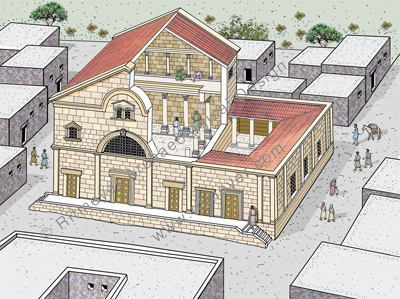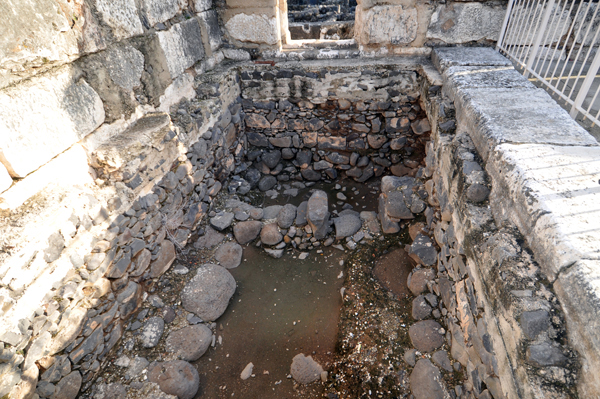The best compliment I can receive about any of my reconstruction drawings is for the viewer to say: “It really makes the site come to life!” Unfortunately, the same cannot be said about photographs, however professionally taken. Take the site of Capernaum, perhaps the most visited site in the Galilee in any tour of the Land. Here, the place in which Jesus taught and in which he cast out an unclean spirit (Mark 1.21-28, Luke 4.31,32) is shown. It is all too easy to shoot photos of your group with the impressive synagogue structure emphasizing the magnificence of its architectural decoration and the dazzling white limestone from which it is built.

But this then is the image you take away with you and the picture that springs to mind when next you read Jesus’ reference to the centurion: “he loves our nation and has built us a synagogue” (Luke 7.5).
But look more closely beneath the ruins of the beautiful white synagogue and you will see that it rests on an older building made of dark stones.

What is the relevance of these? This is where the value of making reconstruction drawings can be shown, with the process allowing historical and archaeological information about the site to be presented in a meaningful way.
When Jesus moved to Capernaum after he was rejected in Nazareth, he brought hope to a part of God’s Land that was in desperate need of it. The dark basalt stones around the Sea of Galilee that were usually used in building were a tangible expression of the darkness felt by: “The land of Zebulon and the land of Naphthali, by the way of the sea, beyond Jordan, Galilee of the Gentiles,” under constant threat of invasion. Jesus’ arrival in the city was a fulfillment of the prophecy of Isaiah: “The people that walked in darkness saw great light; and to them which sat in the region and shadow of death light is sprung up” (Matt 4.15,16).
So, how do the structures made of limestone blocks and that made of basalt differ from each other? Edward Robinson was the first to identify the archaeological remains of Tell Hum, as Capernaum was known at the time, as a synagogue building in 1838. The site of Capernaum was purchased by the Fransciscan Order in 1894. Gaudentius Orfali conducted excavations from 1921 to 1926 and concluded that the synagogue dated from the time of Jesus. Orfali also reconstructed parts of the synagogue, such as the back wall and the columns.
Excavations were renewed in 1968 by Virgilio Corbo and Stanislao Loffreda, who excavated inside the synagogue. The finding of some 10,000 bronze coins below the floor indicated that the white synagogue dated to the late 4th century AD. A lively debate began with Israeli scholars of the time who insisted, on stylistic grounds, that the synagogue dated to the 2nd or 3rd century.
Digging deeper down in 1981, walls made of basalt stones and a basalt floor turned up 4 feet below the surface. These walls were located underneath the walls of the white synagogue and also under the stylobates (low walls that support a row of columns). It was initially thought that these walls were foundation walls, but when 1st century material was found on and below the basalt floor, it became evident that these basalt walls belonged to a synagogue of the 1st century, i.e, the synagogue in which Jesus taught.
Some of the trenches have been left open and the remains of this early synagogue can be seen today.

From these finds it can be concluded that the white Byzantine synagogue was built on the remains of an earlier synagogue and followed a similar plan. A gap in the basalt wall under the east wall indicates that the entrance to the earlier synagogue was from the east and not from the south, as is the case with most of the later synagogues.

In the Byzantine period, the white synagogue would have stood out dramatically from the surrounding black basalt buildings, whereas in the 1st century, the Capernaum synagogue blended into its setting. In the foreground of the reconstruction drawing of the 1st century structure, a figure is depicted bringing the Torah scrolls into the synagogue in a chest on wheels. This detail will be the subject of a forthcoming blog post.


waiting for next blog 🙂
Hello Leen,
Jim Strange and others have commented that the basalt layer was not likely 1st century. If I correctly remember Jodi Magness’ view, she dates the basalt synagogue 2nd or 3rd century CE, and the white synagogue 5th or 6th century (I can’t be sure about this without checking). I don’t remember Stefano’s opinion.
Jim has said (not published) there is evidence of a 1st century building below the basalt but it is now covered over with cement. Perhaps the one Jim saw is limestone like the one in Midgal (1st century BCE).
Any thoughts about this?
Fabulous. Thanks for your continuous teaching of our Lord. Sandy
Jim,
The dating of the two synagogues has stirred many controversies.
Here are some quotes from Jim Strange’s article in BAR Nov/Dec 1983:
“The floor (of the earlier building with basalt walls and a cobbled floor) was doubtless founded in the first century at the latest, and the basalt walls are clearly associated with this floor. But is the earlier building a synagogue? The answer is yes, for several reasons.”
Judy, however, in her book “The Archaeology of the Holy Land”, p. 197, writes: “No remains of a synagogue from the time of Jesus have been found.”
The debate will no doubt continue.
As production designer, I followed your recommendation and went with black basalt in our depiction of Jesus at the Capernaum synagogue:
https://youtu.be/h9M2mprzCF8
John, Looks great!
whats happening to leen our dear friend?? no updates? hope all is well!
Sorry Eli, all is well but have been too busy to post. Will be back soon.
Dear Dr Ritmeyer,
In your post on the carved stone at Capernaum, you referred to the image on my website. In the light of your comments I have revised the caption for this image, but I should point out that Seetheholyland.net is not a Franciscan website but is an independent operation. Perhaps you could amend your post.
Pat McCarthy.
“No remains of a synagogue from the time of Jesus have been found.”
The darker basalt was readily available in the immediate area for construction. During the rebuilding of the white synagogue, limestone would be imported. It seems to me the recovered basalt would be utilized for projects around the village. It would already be shaped and ready to use. In fact, wouldn’t it be a great honor to say “these stones in my house are from the original black synagogue” ? So it seems to me the original stones are still there and might be found in some other structures. Of course, these would be impossible to identify today since the rest of any such structure would be the same type of stone.